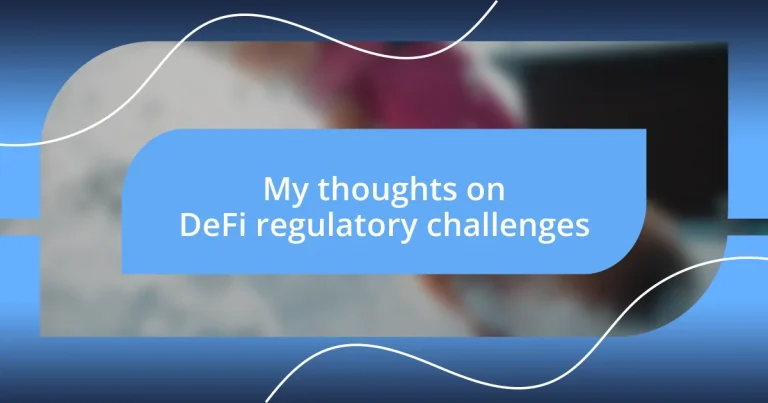Key takeaways:
- Decentralized Finance (DeFi) democratizes access to financial services, leveraging smart contracts for transparency and security.
- Regulatory challenges include unclear classifications, conflict between anonymity and compliance, and the rapid evolution of DeFi outpacing existing regulations.
- Engaging effectively with regulators through proactive communication and education can foster collaboration and create a balanced regulatory environment for innovation in DeFi.
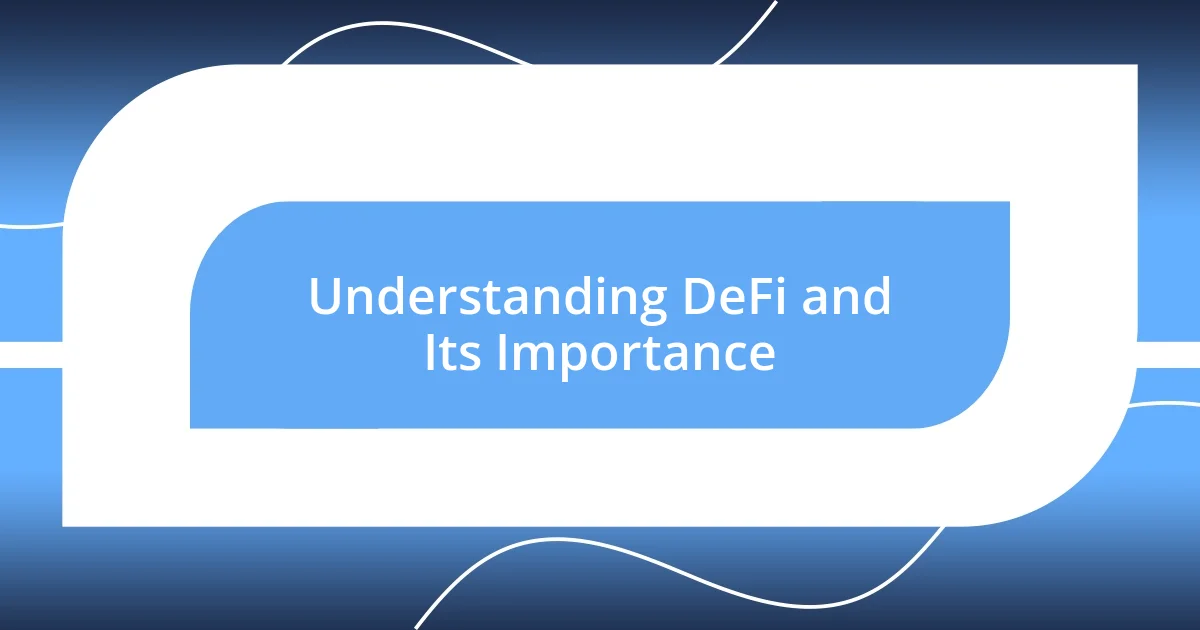
Understanding DeFi and Its Importance
Decentralized Finance, or DeFi, is fundamentally reshaping how we think about money and financial services. I remember the first time I used a DeFi platform; the feeling of empowerment was exhilarating. It was like being handed the keys to a financial kingdom where traditional barriers simply disappeared, making me question why I’d ever relied on banks.
The beauty of DeFi lies in its accessibility. Imagine a world where anyone with an internet connection has the same financial opportunities as the wealthy elite. This democratization of finance speaks to our yearning for equality and inclusivity—don’t we all deserve that chance?
Moreover, the smart contracts that underlie DeFi protocols are fascinating. They eliminate the need for trust in a third party, allowing transactions to be executed automatically based on agreed conditions. Isn’t it amazing how this technology mirrors our innate desire for transparency and security?
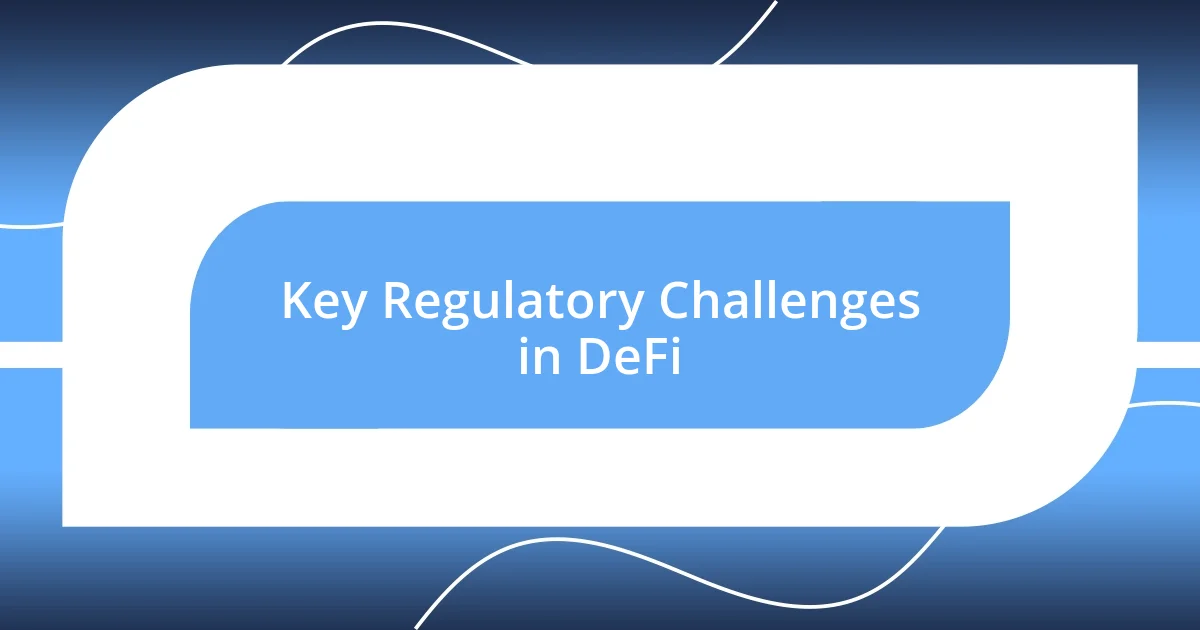
Key Regulatory Challenges in DeFi
Regulatory challenges in DeFi are multifaceted and often daunting. One significant hurdle is the lack of clear frameworks that distinguish between various DeFi projects. I remember grappling with the intricacies of regulatory classifications when I first explored yield farming. Each protocol seemed to have its nuances, and the uncertainty about how they fit into existing laws left me pondering the future of these innovations.
Another crucial issue revolves around anti-money laundering (AML) and know-your-customer (KYC) regulations. Many DeFi platforms prioritize anonymity, which can clash with the need for regulatory compliance. This tug-of-war raises questions about user privacy versus safety. Reflecting on my journey, I can’t help but feel a bittersweet tension; while I appreciate the freedom that DeFi offers, I also understand the importance of protecting the financial system from illicit activities.
Furthermore, the rapidly evolving landscape of DeFi poses challenges for regulators aiming to keep pace. As new financial products and services emerge, regulatory bodies struggle to apply existing regulations effectively. I often think about the implications of this gap; it feels like navigating uncharted waters. The uncertainty can be unsettling for those who wish to invest or engage with DeFi, leaving many waiting to see how the regulatory framework will evolve.
| Challenge | Description |
|---|---|
| Regulatory Classification | Lack of clear definitions for DeFi projects leading to uncertainty in compliance. |
| AML and KYC Compliance | Anonymity in DeFi platforms clashes with regulatory demands for user verification. |
| Regulatory Evolution | Rapid emergence of new DeFi products outpaces existing regulatory frameworks. |
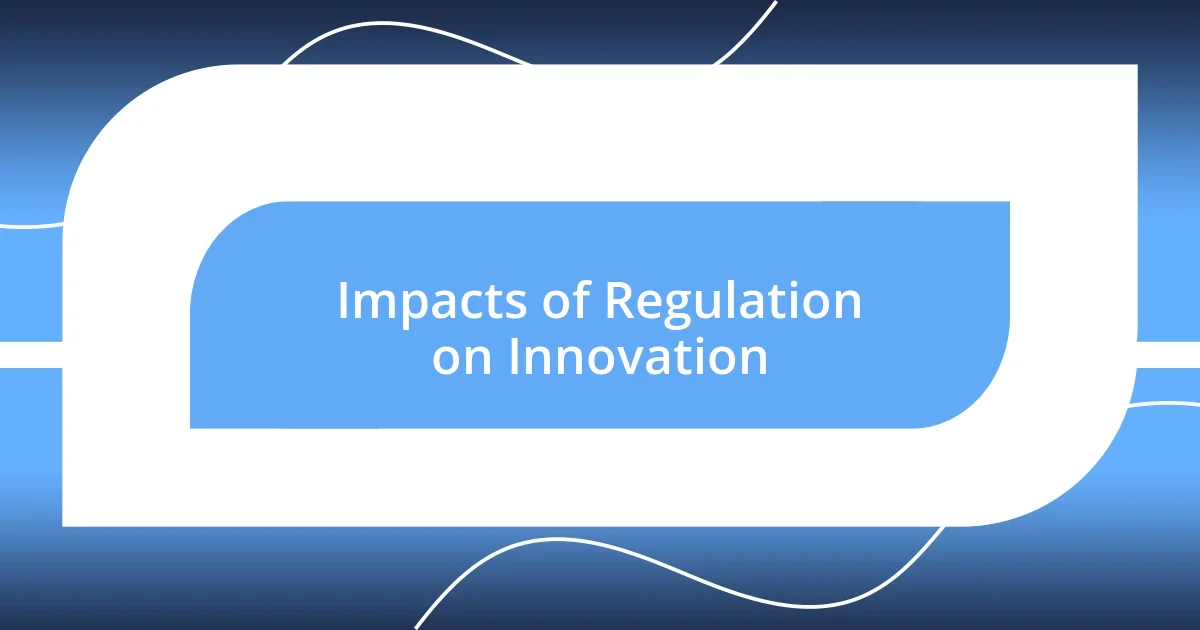
Impacts of Regulation on Innovation
When we think about regulation and innovation, there’s a delicate balance at play. On one hand, regulations can provide a framework that fosters trust among users, but they can also stifle creativity if too rigid. I recall a conversation with a developer who felt their groundbreaking project was sidelined due to uncertainties in regulatory compliance. It’s frustrating because the same forces meant to protect consumers can inadvertently slow down progress.
To illustrate the impacts, consider the following:
- Reduced Experimentation: Strict regulations might discourage startups from testing new ideas, causing a stagnation in innovation.
- Increased Compliance Costs: High costs of meeting regulatory demands can divert resources away from development and toward legal expenses.
- Market Consolidation: Large, entrenched players with the means to comply may dominate the space, leaving smaller innovators struggling to compete.
Regulatory changes often resonate like waves across the industry, sometimes washing away the promising shores of new ideas.
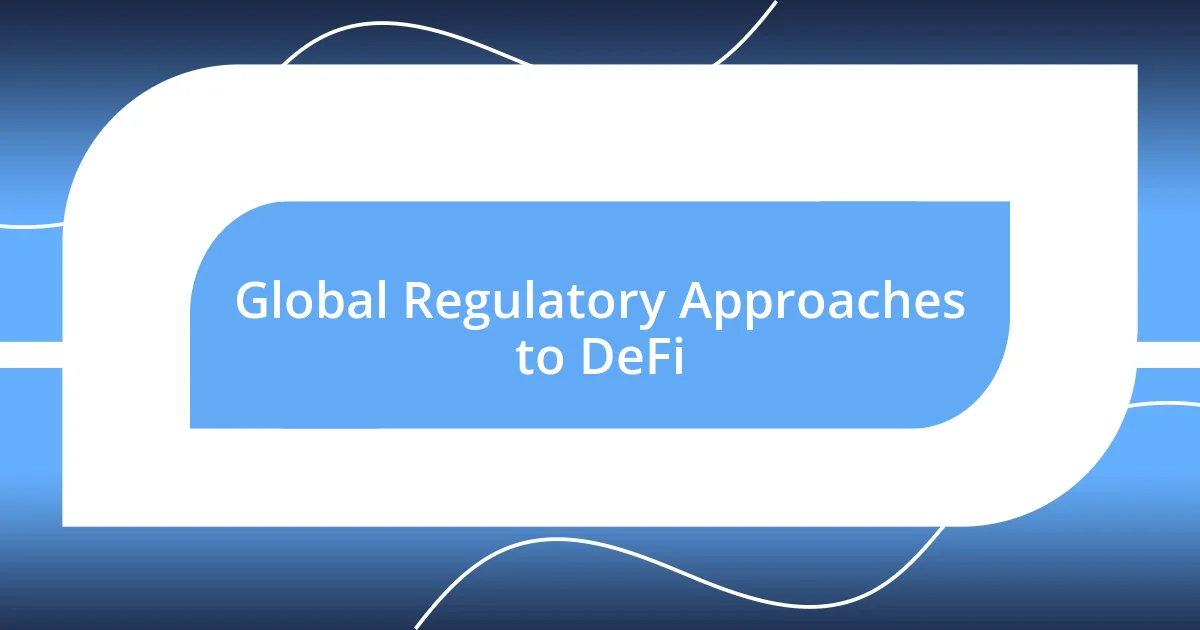
Global Regulatory Approaches to DeFi
Global regulatory approaches to DeFi are anything but uniform. Each country seems to be charting its own path, and I often wonder how this patchwork of regulations impacts global collaboration in this space. From my perspective, I’ve seen regions like Europe adopting stricter oversight, while others, like Switzerland, lean towards fostering innovation through clearer guidelines. This divergence can create confusion for projects trying to operate internationally.
In my experience, the Community of Nations couldn’t be more divided on their stance toward decentralized finance. For instance, while countries like the United States grapple with defining who regulates what, jurisdictions such as Singapore have outlined targeted frameworks that embrace DeFi’s potential. It’s fascinating yet challenging, as I reflect on how these varied approaches can either enhance or hinder global cooperation and investment in DeFi projects.
Looking at Asia, many nations are exploring sandbox models that encourage experimentation within regulated environments. These initiatives resonate with me because they could provide a safe space for innovation. However, I can’t help but think—will these regulated sandboxes ultimately lead to better user protection or simply more bureaucracy? Balancing innovation with safety will be crucial as regulators aim to keep up with this rapidly advancing field.
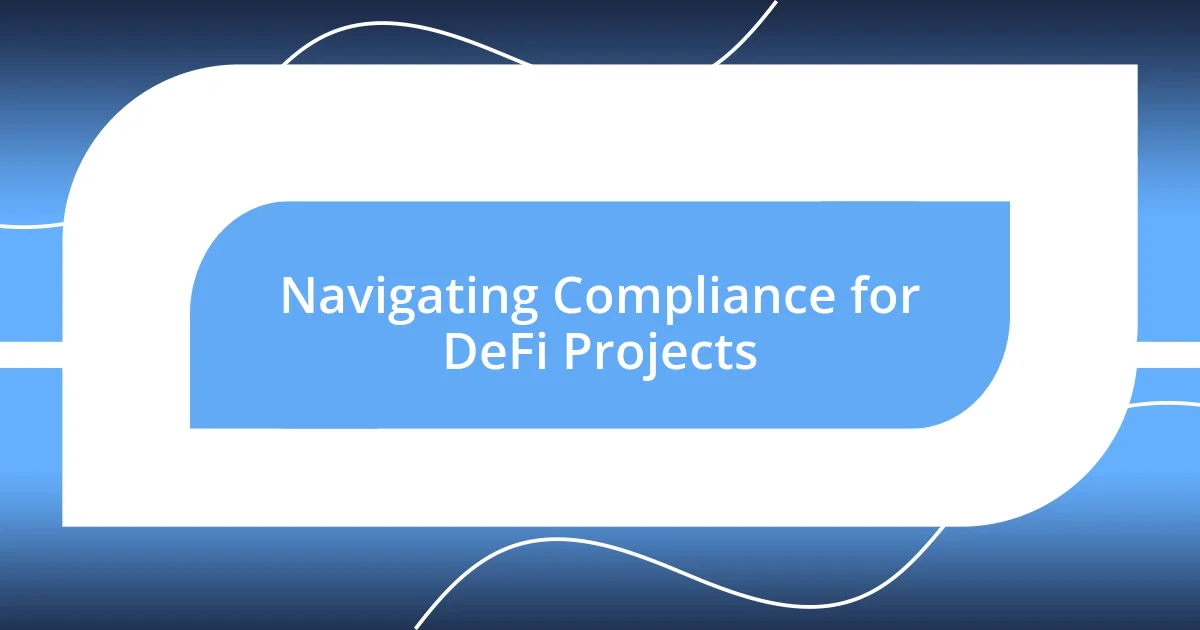
Navigating Compliance for DeFi Projects
Navigating compliance for DeFi projects feels like walking a tightrope. From my involvement in various projects, I’ve seen firsthand how essential it is to build a strong compliance framework right from the start. It’s not just about ticking boxes; understanding the intricate details of regulations can mean the difference between success and costly missteps. Have you ever wondered how a small mistake in compliance could spiral out of control? I’ve witnessed this happen—projects grounded for months due to a single overlooked regulatory detail.
I often advise DeFi developers to cultivate relationships with legal experts early in their journey. It’s crucial to have seasoned professionals on the team who are not just familiar with existing regulations but are also adept at anticipating changes. For instance, I recall a project I consulted for that engaged with compliance specialists during their development phase, and it paid off immensely. They were able to adapt their processes instantly to evolving regulations, which not only saved them time but also built a solid reputation in the community.
Monitoring ongoing regulatory developments is vital; regulations can shift like sand dunes. It can be overwhelming to keep pace with such rapid changes, but I find it empowering to stay proactive. Engaging in industry forums and discussions can provide insights and help navigate murky waters. After all, isn’t it better to be ahead of the curve rather than trying to catch up? Building compliance into the culture of your DeFi project not only fosters resilience but also enhances credibility in a landscape where trust is paramount.
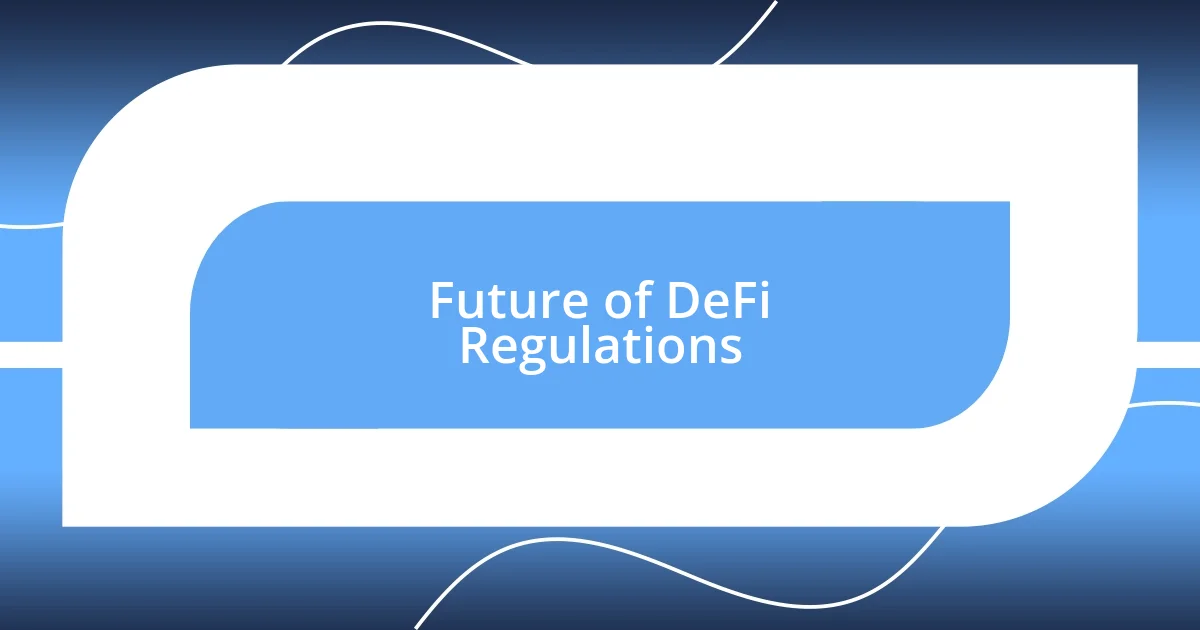
Future of DeFi Regulations
The future of DeFi regulations is undoubtedly a shared concern for innovators and investors alike. Personally, I often think about how the evolution of regulatory frameworks could either empower or stifle creativity in this space. Imagine the possibilities if regulations are designed to foster improvement rather than serve as barriers—could we finally see an era where innovation flourishes alongside compliance?
From my experience, the key will lie in the dynamic interplay between regulators and DeFi projects. I remember attending a conference where regulators and developers were engaged in a discussion that felt more like a collaboration than an interrogation. It struck me then that if both parties can find common ground, the future could hold a promising balance—a regulatory landscape that enables the unencumbered spirit of DeFi while safeguarding users. Isn’t that a vision we all should strive for?
Looking ahead, the adoption of global standards may become essential to unify these disparate regulatory environments. I genuinely believe that if we can collectively create a framework that addresses concerns across borders, we could minimize confusion and foster more significant investment. Will we embrace that vision or continue to chase our tails in fragmented regulations? Only time will tell, but I remain optimistic that thoughtful dialogue can pave the way.
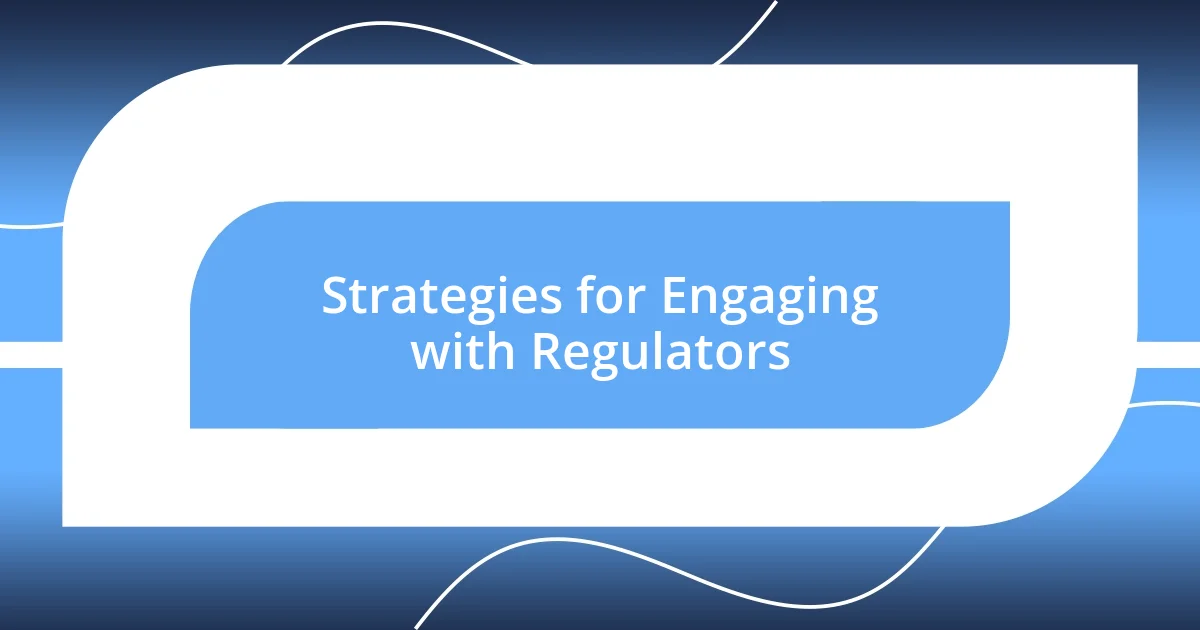
Strategies for Engaging with Regulators
One effective strategy for engaging with regulators is to initiate regular communication. In my prior experiences, I’ve found that reaching out proactively to regulatory bodies can create a rapport that leads to constructive dialogue. Have you ever thought about how much easier it is to navigate complex regulations when you’ve established those crucial lines of communication? I certainly have; it often feels like having a guiding hand through a murky process.
Another approach that’s proved beneficial is to participate in public consultations. I distinctly recall a project I was involved with that took the opportunity to present its viewpoint during a regulatory forum. The feedback loop we established not only allowed us to influence discussions but also gave the regulators insight into the real-world implications of their policies. Isn’t it fascinating how open discussions can lead to better understanding on both sides?
Finally, educating regulators about your technology is vital. During a previous engagement, I organized a workshop for regulators to demystify certain technical aspects of our project. Their eyes lit up as we explored the innovations behind DeFi, showcasing how these advancements could align with regulatory goals. This experience underscored for me the importance of breaking down barriers and ensuring everyone is on the same page—after all, collaboration can steer us toward a more balanced regulatory environment.












